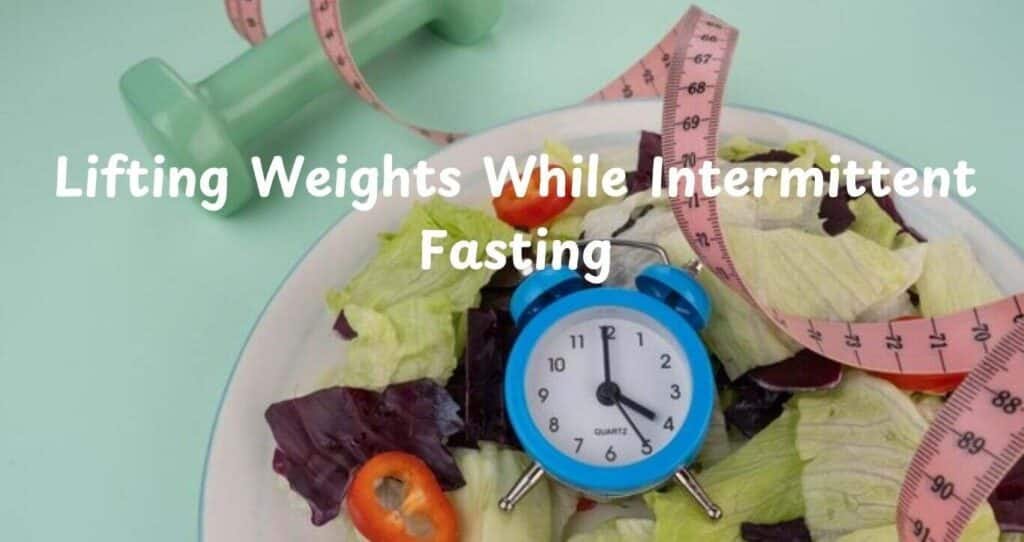Introduction
Intermittent fasting (IF) and weightlifting have become two dynamic duo dominant trends in the fitness industry, captivating the attention of enthusiasts and health-conscious individuals alike. But you might be wondering: Lifting Weights While Intermittent Fasting – is it possible and still achieve muscle growth? The answer is a resounding yes! By thoughtfully merging these two powerful approaches, you can not only maximize fat loss but also enhance muscle development and promote overall health and well-being.

In this detailed guide, we will explore the science behind intermittent fasting and heavy lifting, highlighting the benefits of this dynamic combination. You’ll learn the best way to optimize your workout timings, make necessary dietary adjustments by avoiding calorie deficit, and craft a personalized fitness plan that aligns seamlessly with your individual goals. By the end of this journey, you will possess the knowledge and strategies necessary to harness the full potential of lifting weights while practicing intermittent fasting, empowering you to transform your body and your health.
What Is Intermittent Fasting?
Intermittent fasting (IF) is a unique eating pattern that alternates between periods of fasting and eating, emphasizing not just what you consume but more critically when you consume it. This approach diverges from traditional dieting methods that primarily focus on caloric intake and food choices. Instead, intermittent fasting encourages a structured schedule, leading to various benefits for those who practice it. Here are some of the more popular methods of intermittent fasting:
– 16/8 Method: This widely adopted method involves fasting for 16 hours a day and restricting you’re eating to an 8-hour window. This structure is appealing because it not only allows for a significant fasting duration to encourage fat loss but also provides ample time to consume a variety of nutrients during the designated eating periods.
– 5:2 Diet: In this flexible approach, you eat normally for five days of the week while significantly restricting caloric intake to only 500-600 calories on two non-consecutive days. This method is advantageous as it allows for normal eating patterns on the majority of days, making it easier to adhere to the main goal while still gaining the benefits associated with lower calorie intake on fasting days.

– Eat-Stop-Eat: This method requires fasting for a full 24 hours once or twice a week. Although it can be highly effective for weight loss and metabolic health, it may be more daunting for beginners due to the extended duration without food. However, it can promote significant physiological changes that enhance metabolic processes.
– Time-Restricted Feeding: This approach focuses on consuming all daily meals within a predetermined timeframe, such as a 6- or 8-hour span. By regulating the timing of meals, individuals often find it easier to develop a structured eating habit, promoting better digestion and metabolizing food efficiently.
The primary benefits of intermittent fasting along with an exercise routine include improved insulin sensitivity, which plays a crucial role in regulating blood sugar levels, enhanced fat burning, and the optimization of hormone levels, such as increased growth hormone production. These advantages can together support weight management and medical condition, making intermittent fasting a compelling option for many. However, consult with your nutritionist or a doctor so that your Intermittent fasting work with better efficiency and nil side effects.
Lifting Weights While Intermittent Fasting
Lifting weights in a fasted state refers to engaging in strength training after a period of not consuming any calories, often occurring in the hours leading up to your first meal of the day. While many people harbor the belief that this practice can lead to muscle loss, the science behind it offers a much more nuanced perspective.
1. Fat Loss vs. Muscle Loss
A prevalent myth surrounding the concept of fasted weightlifting is the fear of losing muscle mass. However, emerging research indicates that fasting may enhance growth hormone production, a key player in preserving lean muscle tissue while simultaneously accelerating fat loss. When individuals partake in strength training, the act of lifting weights stimulates muscle protein synthesis, a process that facilitates the maintenance and repair of muscle fibers even when the body is in a fasted state. This means that not only can you burn fat, but you can also protect and potentially enhance muscle mass during your workouts.
2. Insulin Sensitivity and Muscle Growth
Fasting has been shown to improve insulin sensitivity, which fundamentally transforms how your body utilizes nutrients. When insulin sensitivity is high, your muscles are better equipped to absorb glucose and amino acids, both vital for muscle recovery and growth. This efficiency leads to optimal replenishment of glycogen stores following intense workouts, which is crucial for sustained energy levels. Moreover, improved insulin sensitivity can significantly lower the risk of developing insulin resistance, a condition often linked to obesity and various metabolic disorders, thus promoting overall health and fitness.

3. Energy Levels, Performance and sleep
Despite concerns about potential energy deficits during fasted workouts, many athletes report experiencing heightened mental clarity and sustained energy levels. This phenomenon occurs because the body learns to efficiently tap into stored fat reserves for fuel, ensuring a consistent energy supply during workouts. While glycogen levels may decrease when training in a fasted state, the body excels in fat oxidation, creating a reliable source of energy. Additionally, incorporating a cup of black coffee or herbal tea before exercising can further sharpen focus and enhance performance, making it a popular choice among those looking to maximize their workout efficiency.
Quality sleep, particularly REM sleep, plays a crucial role in energy levels and workout performance. REM sleep supports cognitive function, muscle recovery, and overall motivation. Lack of deep, restorative sleep can lead to increased cortisol levels, reduced energy, and poor muscle recovery, making it harder to sustain a consistent fasting and weightlifting routine.
Lifting heavy weights while fasting may not only be safe but can also provide unique advantages for muscle preservation, nutrient absorption, and overall workout performance.
The Benefits of Combining Weightlifting with Intermittent Fasting
1. Enhanced Fat Burning
When you engage in weightlifting while in a fasted state, your body shifts its primary source of energy from readily available carbohydrates to stored fat reserves. This transition promotes a process known as fat oxidation, which can lead to noticeable body composition changes over time. For individuals striving to shed excess body fat without sacrificing muscle mass, this approach can be particularly advantageous. As you consistently embrace this method, you may achieve a leaner physique and experience improvements in metabolic health.
2. Improved Insulin Sensitivity
Intermittent fasting plays a crucial role in regulating blood sugar levels, which helps guard against insulin resistance, an issue that can hinder muscle growth and recovery. By enhancing insulin sensitivity, the body becomes more adept at transporting vital nutrients directly to muscle cells. This efficient nutrient delivery not only supports optimal performance during workouts but also facilitates quicker recovery afterward, enabling individuals to train harder and more frequently.
3. Hormone Optimization
One of the remarkable effects of intermittent fasting is its ability to elevate levels of human growth hormone (HGH). This hormone is pivotal in muscle development and fat reduction; elevated HGH levels aid in breaking down fat and preserving lean muscle mass. As a result, incorporating fasting into your routine can serve as a potent strategy for achieving body recomposition, making it easier to shift towards a healthier, more sculpted physique.
Also, REM sleep enhances hormonal balance, helping regulate HGH, testosterone, and cortisol. Poor sleep can disrupt these hormones, negatively affecting fat loss, muscle gain, and overall recovery.

4. Convenience and Simplicity
One of the standout advantages of intermittent fasting is its inherent simplicity. By streamlining meal planning, it becomes easier to adhere to a nutritional plan without the constant concern of meal timing and preparation. With fewer meals to prepare, individuals can dedicate more time to their workouts and recovery, thus enhancing their overall fitness journey.
5. Mental Clarity and Focus
Fasted workouts often come with a surprising bonus: enhanced mental clarity. Many individuals report experiencing heightened focus and alertness during training sessions when in a fasted state. This improvement is largely attributed to an increase in norepinephrine production, a neurotransmitter that bolsters concentration and mental sharpness. As a result, you may find that your training sessions not only become more productive but also more enjoyable.
How to Lift Weights While Intermittent Fasting
1. Choose the Right Fasting Schedule
Selecting an effective fasting schedule is vital for maximizing your training results. The 16/8 method stands out as one of the most beneficial approaches for those who lift weights. This entails fasting from 8 PM until 12 PM the next day, during which you abstain from caloric intake. From 12 PM to 8 PM, on the following day, you can enjoy a nutritious eating window that supports muscle recovery and growth. This approach facilitates the metabolic benefits of fasting and ensures you have ample time to consume the nutrients your body needs for optimal performance.
2. Best Time to Train While Fasting
Timing your workouts strategically can greatly influence your performance and recovery. The ideal time to lift weights is near the end of your fasting period, typically in the late morning or early afternoon. Training during this time allows you to break your fast immediately after your workout, which is crucial for replenishing glycogen stores depleted during exercise. This post-workout meal should be rich with enough calories in both protein and carbohydrates to ensure maximum muscle repair and recovery after lifting sessions.

3. Prioritize Protein Intake
During your designated eating window, it is essential to focus on your protein intake to support muscle maintenance and growth. Aim to consume between 1.6 to 2.2 grams of protein for every kilogram of your body weight. Incorporating high-quality protein sources is key; such options may include lean cuts of meat, fresh fish, eggs, or plant-based proteins like legumes and tofu. Adequate protein intake has potential benefits that will optimize muscle protein synthesis, ensuring your body can effectively recover from workouts and build new muscle tissue.
4. Stay Hydrated
Maintaining hydration is crucial for intense workout performance and overall well-being. Throughout the day, prioritize drinking plenty of water, and consider beverages like black coffee or herbal tea, which can provide an energy boost without breaking your fast. Remember, dehydration can significantly harm your exercise performance, leading to fatigue and decreased endurance. Therefore, sustaining an adequate fluid intake is essential, especially as you engage in physical activities.
5. Incorporate Different Types of Exercise
While weight training is fundamental to building muscles, diversifying your exercise regime can enhance your overall fitness and health. Incorporating various forms of exercise, such as aerobic exercise, high-intensity sprint training, and even lower-intensity activities like yoga, can provide comprehensive benefits. A well-rounded approach that blends resistance training with cardiovascular exercises will not only improve your muscle strength but also support metabolic health and enhance your overall physical conditioning.
Common mistakes About Fasted Weightlifting
Fasted Workouts and Muscle Loss
Many people believe that engaging in workouts while fasted leads to muscle loss. In reality, as long as individuals ensure they are consuming an adequate amount of protein and overall calories during their designated eating periods, fasting does not inherently result in muscle degradation. Incorporating resistance training into a fitness routine can effectively help preserve muscle tissue. Moreover, fasting triggers beneficial hormonal changes that can enhance the body’s ability to maintain muscle.
The Feeling of Weakness in Fasted Workouts
A common concern among those considering fasted workouts is the perception that they will feel weak or fatigued. However, many individuals report otherwise. Once the body adapts to utilizing fat as its primary source of fuel during workouts, many people experience sustained energy levels and improved mental clarity. Initially, there may be an adjustment period, but as athletes become acclimated to this form of training, they often find themselves feeling even stronger and more energized throughout their sessions.

Intermittent Fasting – Beyond Weight Loss
Another misconception about intermittent fasting (IF) is that it is solely a tool for weight loss. In truth, IF offers a wide array of health benefits that extend far beyond mere weight management. These benefits include hormone optimization, enhanced metabolic health, and improved recovery times. Intermittent fasting can be strategically employed not just for shedding pounds but also to gain muscle and achieve a fitness level. It’s a versatile approach that can cater to various fitness.
The Best of Intermittent Fasting in Amazon
If you’re serious about transforming your health, Fast Like a Girl is the ultimate guide every woman needs! This book unravels the science of intermittent fasting while addressing the unique hormonal shifts women experience—making it a game-changer for weight loss, energy, and longevity. Unlike generic fasting guides, it empowers women to fast in harmony with their cycles, optimizing their metabolism without harming their hormones. Whether you are navigating perimenopause, pregnancy, or menopause, this book arms you with expert-backed strategies, meal plans, and practical tips to make fasting sustainable and effective. Don’t just follow a trend—understand your body, take control, and unlock the power of fasting like never before!
Conclusion – The Powerful Combination of Fasting and Weightlifting
Engaging in weightlifting while practicing intermittent fasting is an immensely effective strategy for maximizing fat loss, maintaining lean muscle mass, and improving your overall health. By carefully planning the timing of your workouts, emphasizing the importance of proper nutrition, and being attuned to your body’s signals, you can fully harness the benefits of this powerful approach.
Whether your primary goal is to shed fat mass, build muscle, or enhance your overall fitness level, this combination of intermittent fasting and weight training can significantly elevate your results. Take the time to experiment with this method, and commit to a consistent routine, and you’ll be able to experience the transformative effects of combining these two practices.
By adhering to these strategies, you will not only fine-tune your fitness regimen but also enjoy the multitude of health benefits of intermittent fasting. Stay dedicated, and as the days turn into weeks, you’ll witness striking improvements in your body composition, higher energy levels, and a general sense of well-being. Embrace the journey and enjoy your lifting experience!



